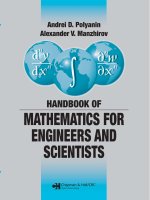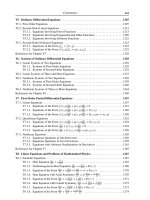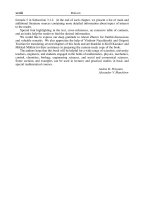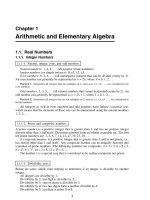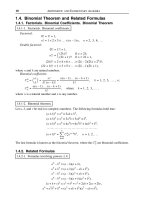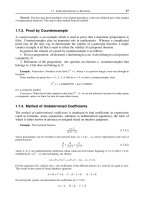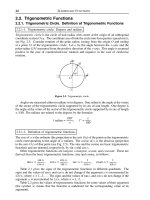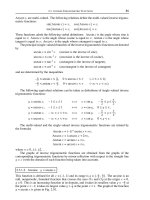Handbook of mathematics for engineers and scienteists part 11 ppsx
Bạn đang xem bản rút gọn của tài liệu. Xem và tải ngay bản đầy đủ của tài liệu tại đây (375 KB, 7 trang )
38 ELEMENTARY FUNCTIONS
2.4.2-7. Hyperbolic functions of multiple argument.
cosh 2x = 2 cosh
2
x –1,
cosh 3x =–3 cosh x +4 cosh
3
x,
cosh 4x = 1 –8 cosh
2
x + 8 cosh
4
x,
cosh 5x = 5 cosh x –20 cosh
3
x + 16 cosh
5
x,
sinh 2x = 2 sinh x cosh x,
sinh 3x = 3 sinh x + 4 sinh
3
x,
sinh 4x = 4 cosh x(sinh x + 2 sinh
3
x),
sinh 5x = 5 sinh x + 20 sinh
3
x + 16 sinh
5
x.
cosh(nx)=2
n–1
cosh
n
x +
n
2
[n/2]
k=0
(–1)
k+1
k +1
C
k–2
n–k–2
2
n–2k–2
(cosh x)
n–2k–2
,
sinh(nx)=sinhx
[(n–1)/2]
k=0
2
n–k–1
C
k
n–k–1
(cosh x)
n–2k–1
.
Here, C
k
m
are binomial coefficients and [A] stands for the integer part of the number A.
2.4.2-8. Hyperbolic functions of half argument.
sinh
x
2
=signx
cosh x – 1
2
,cosh
x
2
=
cosh x + 1
2
,
tanh
x
2
=
sinh x
cosh x + 1
=
cosh x – 1
sinh x
,coth
x
2
=
sinh x
cosh x – 1
=
cosh x + 1
sinh x
.
2.4.2-9. Differentiation formulas.
d sinh x
dx
=coshx,
d cosh x
dx
=sinhx,
d tanh x
dx
=
1
cosh
2
x
,
d coth x
dx
=–
1
sinh
2
x
.
2.4.2-10. Integration formulas.
sinh xdx =coshx + C,
cosh xdx=sinhx + C,
tanh xdx =lncoshx + C,
coth xdx=ln| sinh x| + C,
where C is an arbitrary constant.
2.5. INVERSE HYPERBOLIC FUNCTIONS 39
2.4.2-11. Expansion in power series.
cosh x = 1 +
x
2
2!
+
x
4
4!
+
x
6
6!
+ ···+
x
2n
(2n)!
+ ··· (|x| < ∞),
sinh x = x +
x
3
3!
+
x
5
5!
+
x
7
7!
+ ···+
x
2n+1
(2n +1)!
+ ··· (|x| < ∞),
tanh x = x –
x
3
3
+
2x
5
15
–
17x
7
315
+ ···+(–1)
n–1
2
2n
(2
2n
– 1)|B
2n
|x
2n–1
(2n)!
+ ··· (|x| < π/2),
coth x =
1
x
+
x
3
–
x
3
45
+
2x
5
945
– ···+(–1)
n–1
2
2n
|B
2n
|x
2n–1
(2n)!
+ ··· (|x| < π),
where B
n
are Bernoulli numbers (see Subsection 18.1.3).
2.4.2-12. Relationship with trigonometric functions.
sinh(ix)=i sin x,cosh(ix)=cosx,tanh(ix)=i tan x,coth(ix)=–i cot x, i
2
=–1.
2.5. Inverse Hyperbolic Functions
2.5.1. Definitions. Graphs of Inverse Hyperbolic Functions
2.5.1-1. Definitions of inverse hyperbolic functions.
Inverse hyperbolic functions are the functions that are inverse to hyperbolic functions. The
following notation is used for inverse hyperbolic functions:
arcsinh x ≡ sinh
–1
x (inverse of hyperbolic sine),
arccosh x ≡ cosh
–1
x (inverse of hyperbolic cosine),
arctanh x ≡ tanh
–1
x (inverse of hyperbolic tangent),
arccoth x ≡ coth
–1
x (inverse of hyperbolic cotangent).
Inverse hyperbolic functions can be expressed in terms of logarithmic functions:
arcsinh x =ln
x +
√
x
2
+ 1
(x is any); arccosh x =ln
x +
√
x
2
– 1
(x ≥ 1);
arctanh x =
1
2
ln
1 + x
1 – x
(|x| < 1); arccoth x =
1
2
ln
x + 1
x – 1
(|x| > 1).
Here, only one (principal) branch of the function arccosh x is listed, the function itself being
double-valued. In order to write out both branches of arccosh x, the symbol
should be
placed before the logarithm on the right-hand side of the formula.
Below, the graphs of the inverse hyperbolic functions are given. These are obtained
from the graphs of the corresponding hyperbolic functions by mirror reflection with respect
to the straight line y = x (with the domain of each function being taken into account).
2.5.1-2. Inverse hyperbolic sine: y =arcsinhx.
This function is defined for all x, and its range coincides with the y-axis. The arcsinh x is an
odd, nonperiodic, unbounded function that crosses the axes Ox and Oy at the origin x = 0,
y = 0. This is an increasing function on the entire real axis with no points of extremum.
The graph of the function y =arcsinhx is given in Fig. 2.18.
40 ELEMENTARY FUNCTIONS
2.5.1-3. Inverse hyperbolic cosine: y = arccosh x.
This function is defined for all x [1,+∞ ), and its range consists of y [0,+∞). The
arccosh x is neither odd nor even; it is nonperiodic and unbounded. It does not cross the
axis Oy and crosses the axis Ox at the point x = 1. It is an increasing function in its domain
with the minimal value y = 0 at x = 1. The graph of the function y = arccosh x is given in
Fig. 2.19.
O
1
1
2
x
y
1
1
2
yxarcsinh=
Figure 2.18. The graph of the function y =arcsinhx.
O
1
1
2
3
4
2
x
y
yxarccosh=
Figure 2.19. The graph of the function y = arccosh x.
2.5.1-4. Inverse hyperbolic tangent: y =arctanhx.
This function is defined for all x (–1, 1), and its range consists of all y. The arctanh x
is an odd, nonperiodic, unbounded function that crosses the coordinate axes at the origin
x = 0, y = 0. This is an increasing function in its domain with no points of extremum and
an inflection point at the origin. It has two vertical asymptotes: x =
1. The graph of the
function y =arctanhx is given in Fig. 2.20.
2.5.1-5. Inverse hyperbolic cotangent: y = arccoth x.
This function is defined for x (–∞,–1)andx (1,+∞). Its range consists of all y ≠ 0.
The arccoth x is an odd, nonperiodic, unbounded function that does not cross the coordinate
axes. It is a decreasing function on each of the semiaxes of its domain. This function has
no points of extremum and has one horizontal asymptote y = 0 and two vertical asymptotes
x =
1. The graph of the function y = arccoth x is given in Fig. 2.21.
O
1
1
2
x
y
1
2
yxarctanh=
1
Figure 2.20. The graph of the function y =arctanhx.
O
1
x
y
1
yxarccoth=
Figure 2.21. The graph of the function y = arccoth x.
2.5. INVERSE HYPERBOLIC FUNCTIONS 41
2.5.2. Properties of Inverse Hyperbolic Functions
2.5.2-1. Simplest relations.
arcsinh(–x)=–arcsinhx, arctanh(–x)=–arctanhx, arccoth(–x) = – arccoth x.
2.5.2-2. Relations between inverse hyperbolic functions.
arcsinh x = arccosh
√
x
2
+ 1 =arctanh
x
√
x
2
+ 1
,
arccosh x =arcsinh
√
x
2
– 1 =arctanh
√
x
2
– 1
x
,
arctanh x =arcsinh
x
√
1 – x
2
= arccosh
1
√
1 – x
2
= arccoth
1
x
.
2.5.2-3. Addition and subtraction of inverse hyperbolic functions.
arcsinh x arcsinh y =arcsinh
x
1 + y
2
y
√
1 + x
2
,
arccosh x
arccosh y = arccosh
xy
(x
2
– 1)(y
2
– 1)
,
arcsinh x
arccosh y =arcsinh
xy
(x
2
+ 1)(y
2
– 1)
,
arctanh x
arctanh y =arctanh
x y
1 xy
,arctanhx arccoth y =arctanh
xy 1
y x
.
2.5.2-4. Differentiation formulas.
d
dx
arcsinh x =
1
√
x
2
+ 1
,
d
dx
arctanh x =
1
1 – x
2
(x
2
< 1),
d
dx
arccosh x =
1
√
x
2
– 1
,
d
dx
arccoth x =
1
1 – x
2
(x
2
> 1).
2.5.2-5. Integration formulas.
arcsinh xdx= x arcsinh x –
√
1 + x
2
+ C,
arccosh xdx= x arccosh x –
√
x
2
– 1 + C,
arctanh xdx= x arctanh x +
1
2
ln(1 – x
2
)+C,
arccoth xdx= x arccoth x +
1
2
ln(x
2
– 1)+C,
where C is an arbitrary constant.
42 ELEMENTARY FUNCTIONS
2.5.2-6. Expansion in power series.
arcsinh x = x –
1
2
x
3
3
+
1×3
2×4
x
5
5
– ···+(–1)
n
1×3×···× (2n – 1)
2×4×···× (2n)
x
2n+1
2n + 1
+ ··· (|x| < 1),
arcsinh x =ln(2x)+
1
2
1
2x
2
+
1×3
2×4
1
4x
4
+ ···+
1×3×···× (2n – 1)
2×4×···× (2n)
1
2nx
2n
+ ··· (|x| > 1),
arccosh x =ln(2x)–
1
2
1
2x
2
–
1×3
2×4
1
4x
4
– ···–
1×3×···× (2n – 1)
2×4×···× (2n)
1
2nx
2n
– ··· (|x| > 1),
arctanh x = x +
x
3
3
+
x
5
5
+
x
7
7
+ ···+
x
2n+1
2n + 1
+ ··· (|x| < 1),
arccoth x =
1
x
+
1
3x
3
+
1
5x
5
+
1
7x
7
+ ···+
1
(2n + 1)x
2n+1
+ ··· (|x| > 1).
References for Chapter 2
Abramowitz,M.andStegun,I.A.(Editors),Handbook of Mathematical Functions with Formulas, Graphs
and Mathematical Tables, National Bureau of Standards Applied Mathematics, Washington, D. C., 1964.
Adams, R., Calculus: A Complete Course, 6th Edition, Pearson Education, Toronto, 2006.
Anton, H., Bivens, I., and Davis, S., Calculus: Early Transcendental Single Variable, 8th Edition, John Wiley
& Sons, New York, 2005.
Bronshtein, I. N. and Semendyayev, K. A., Handbook of Mathematics, 4th Edition, Springer-Verlag, Berlin,
2004.
Courant, R. and John, F., Introduction to Calculus and Analysis, Vol. 1, Springer-Verlag, New York, 1999.
Edwards, C. H., and Penney, D., Calculus, 6th Edition, Pearson Education, Toronto, 2002.
Gradshteyn,I.S.andRyzhik,I.M.,Tables of Integrals, Series, and Products, 6th Edition, Academic Press,
New York, 2000.
Kline, M., Calculus: An Intuitive and Physical Approach, 2nd Edition, Dover Publications, New York, 1998.
Korn,G.A.andKorn,T.M.,Mathematical Handbook for Scientists and Engineers, 2nd Edition, Dover
Publications, New York, 2000.
Prudnikov, A. P., Brychkov, Yu. A., and Marichev, O. I., Integrals and Series, Vol. 1, Elementary Functions,
Gordon & Breach, New York, 1986.
Sullivan, M., Trigonometry, 7th Edition, Prentice Hall, Englewood Cliffs, 2004.
Thomas, G. B. and Finney, R. L., Calculus and Analytic Geometry, 9th Edition, Addison Wesley, Reading,
Massachusetts, 1996.
Weisstein, E. W., CRC Concise Encyclopedia of Mathematics, 2nd Edition, CRC Press, Boca Raton, 2003.
Zill, D. G. and Dewar, J. M., Trigonometry, 2nd Edition, McGraw-Hill, New York, 1990.
Zwillinger, D., CRC Standard Mathematical Tables and Formulae, 31st Edition, CRC Press, Boca Raton, 2002.
Chapter 3
Elementary Geometry
3.1. Plane Geometry
3.1.1. Triangles
3.1.1-1. Plane triangle and its properties.
1
◦
.Aplane triangle,orsimplyatriangle,isaplanefigure bounded by three straight line
segments (sides) connecting three noncollinear points (vertices) (Fig. 3.1a). The smaller
angle between the two rays issuing from a vertex and passing through the other two vertices
is called an (interior) angle of the triangle. The angle adjacent to an interior angle is called
an external angle of the triangle. An external angle is equal to the sum of the two interior
angles to which it is not adjacent.
A
a
(a)(b)
α
b
c
γ
β
B
C
Figure 3.1. Planetriangle(a). Midline of a triangle (b).
A triangle is uniquely determined by any of the following sets of its parts:
1. Two angles and their included side.
2. Two sides and their included angle.
3. Three sides.
Depending on the angles, a triangle is said to be:
1. Acute if all three angles are acute.
2. Right (or right-angled) if one of the angles is right.
3. Obtuse if one of the angles is obtuse.
Depending on the relation between the side lengths, a triangle is said to be:
1. Regular (or equilateral) if all sides have the same length.
2. Isosceles if two of the sides are of equal length.
3. Scalene if all sides have different lengths.
2
◦
. Congruence tests for triangles:
1. If two sides of a triangle and their included angle are congruent to the corresponding
parts of another triangle, then the triangles are congruent.
2. If two angles of a triangle and their included side are congruent to the corresponding
parts of another triangle, then the triangles are congruent.
43
44 ELEMENTARY GEOMETRY
3. If three sides of a triangle are congruent to the corresponding sides of another triangle,
then the triangles are congruent.
3
◦
. Triangles are said to be similar if their corresponding angles are equal and their corre-
sponding sides are proportional.
Similarity tests for triangles:
1. If all three pairs of corresponding sides in a pair of triangles are in proportion, then the
triangles are similar.
2. If two pairs of corresponding angles in a pair of triangles are congruent, then the triangles
are similar.
3. If two pairs of corresponding sides in a pair of triangles are in proportion and the
included angles are congruent, then the triangles are similar.
The areas of similar triangles are proportional to the squares of the corresponding linear
parts (such as sides, altitudes, diagonals, etc.).
4
◦
. The line connecting the midpoints of two sides of a triangle is called a midline of the
triangle. The midline is parallel to and half as long as the third side (Fig. 3.1b).
Let a, b,andc be the lengths of the sides of a triangle; let α, β,andγ be the respective
opposite angles (Fig. 3.1a); let R and r be the circumradius and the inradius, respectively;
and let p =
1
2
(a + b + c) be the semiperimeter.
Table 3.1 represents the basic properties and relations characterizing triangles.
TABLE 3.1
Basic properties and relations characterizing plane triangles
No.
The name of property Properties and relations
1
Triangle inequality
The length of any side of a triangle does not exceed
the sum of lengths of the other two sides
2
Sum of angles of
a triangle
α + β + γ = 180
◦
3
Law of sines
a
sin α
=
b
sin β
=
c
sin γ
= 2R
4
Law of cosines
c
2
= a
2
+ b
2
– 2ab cos γ
5
Law of tangents
a + b
a – b
=
tan
1
2
(α + β)
tan
1
2
(α – β)
=
cot
1
2
γ
tan
1
2
(α – β)
6
Theorem on projections
(law of cosines)
c = a cos β + b cos α
7
Trigonometric
angle formulas
sin
γ
2
=
(p – a)(p – b)
ab
,cos
γ
2
=
p(p – c)
ab
,
tan
γ
2
=
(p – a)(p – b)
p(p – c)
,sinγ =
2
ab
p(p – a)(p – b)(p – c)
8
Law of tangents
tan γ =
c sin α
b – c cos α
=
c sin β
a – c cos β
9
Mollweide’s formulas
a + b
c
=
cos
1
2
(α – β)
sin
1
2
γ
=
cos
1
2
(α – β)
cos
1
2
(α + β)
,
a – b
c
=
sin
1
2
(α – β)
cos
1
2
γ
=
sin
1
2
(α – β)
sin
1
2
(α + β)
